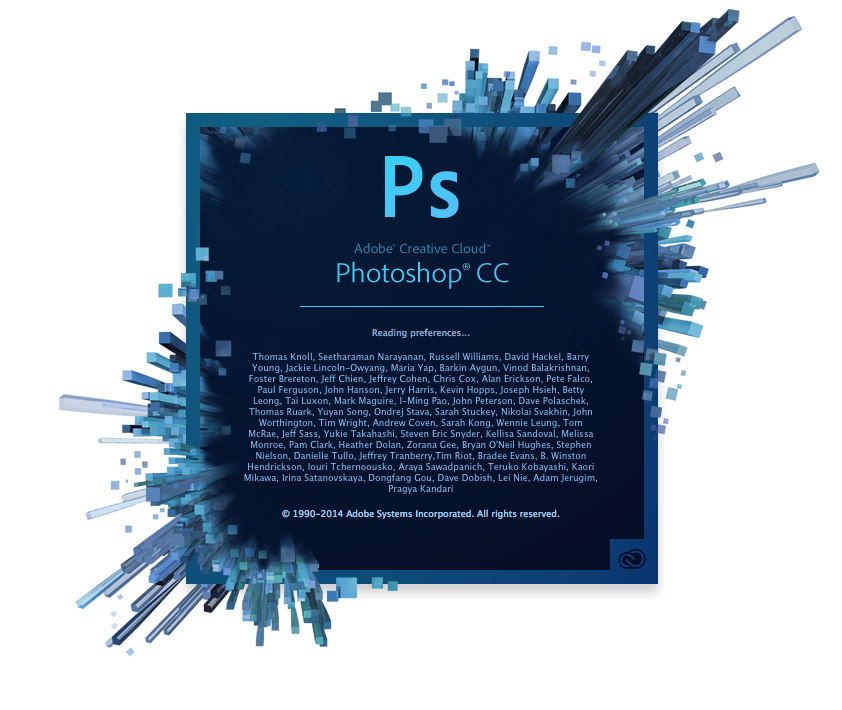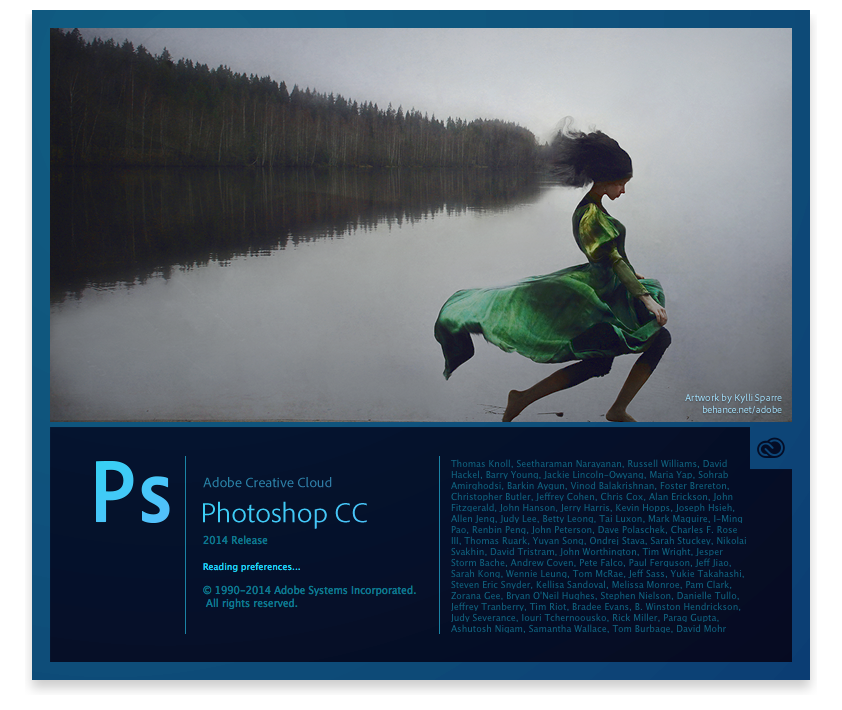Adobe Photoshop CC 2014: what's new?

Today, Adobe has released a global update for all Creative Cloud products. And at the same time the design of the site www.adobe.com changed.
Almost all applications have made some changes. At the same time, the package did not receive the expected name CC2, but only added a year in the title. So now the version of Photoshop is called CC 2014.0.0, not CC2 or 15.0.
')
Here is what the screensavers look like when running in Photoshop CC 14.2.1 and Photoshop CC 2014:


Slightly changed the view in the About window:


And this is what the “alternative” screensaver of both versions looks like, which is invoked (on a Mac) by Photoshop> About Photoshop ... with the Alt and Cmd keys pressed:

The icon of the application has not changed.
A new photoshop is loaded on my computer somewhere around 5-6 seconds faster, the total startup time is 12 seconds. In this paper, the new Photoshop is a bit more nimble than its predecessor, but it didn’t get very fast. But he eats 20-30 megabytes more memory.
I must say that now when Photoshop CC (2014) exits on my computer, it gives an error every time. Obviously, this bug will be fixed in the next update. But not very nice.
First of all, a small change in the style of controls near the dialog boxes is striking. Buttons and checkboxes now look slightly different. This is how it was in PS 14.2:

But in the new version:

As you can see, the windows became more compact, the distances between controls slightly increased, the text on the left became larger, the background of the windows darkened a little, and all the buttons and checkboxes lost their blue tint and became flatter. It’s as if Adobe is preparing for the release of Yosemite, but they didn’t dare to make a full flat, and carefully reduced the level of gradients. At first, this kind of a little annoying, but then you quickly get used to it.
All panels have increased the size of the fonts, so now you do not need to strain your eyes on large monitors:

Small changes have touched the New window: now the Advanced options are always shown, they do not need to be opened with an additional click, and in the new preset creation window they renamed some items:

The windows for opening and recording documents, as well as Save for Web, have not changed much.
Now let's look at the basic functionality of the updated photoshop.
Perhaps the most important innovation that will appeal to many is the ability to dynamically track the distances to the borders of objects and the edges of a document. Obviously, this feature was borrowed from Sketch, which I wrote about in my recent article .
Now when copying an object with the Alt key pressed, all distances from the borders of the original are dynamically displayed:

When the Cmd key is pressed (Ctrl in Windows) and pointing to an object, the distance to it is shown. Moreover, this value changes dynamically if the object is moved by arrows on the keyboard:

If you hover while holding the Cmd key on an empty area not occupied by any objects, then the distances to the document borders are shown:

And, finally, when copying objects with the Alt key pressed at a certain moment, the next copy will jump into the place with the same indent value as the previous copy, and this value will be displayed on the screen. This is very convenient for quickly placing multiple copies at the same distance from each other:

Very interesting was the possibility of smart objects not only to include in the body of the document, but also to implement as Linked Smart-Objects. This should reduce the size of the received documents and speed up the workflow somewhat.
In addition, improved work with Layer Comps, where you can now operate with linked smart objects. It is still difficult to assess this addition, but I think it will be useful for many. Especially for those who regularly work with large layouts.
By the way, about the size. Now you can import giant PNG files with a size of up to 2 GB.
Somewhat improved the work with fonts. For example, when opening a document with fonts that are not on your system, you will now receive a dialog box instead of the annoying warning, which allows you to find the right fonts.
Added TypeKit support and font search.
And now, flipping through the list of fonts, you will see an instant display of the font directly on the selected text object. Very useful.
But, alas, support for standard system smoothing with sub-pixel rendering has not yet appeared.
For web developers, a nice little thing has been added: now the Inner Shadow effect also gets into the Copy CSS command.
Very curious to do with the effects of blur. Now they are countless. And they are divided into Blur (Average, Blur, Blur More, Box Blur, Gaussian Blur, Lens Blur, Motion Blur, Radial Blur, Shape Blur, Smart Blur, Surface Blur) and Blur Gallery (Field Blur, Iris Blur, Tilt-Shift , Path Blur, Spin Blur). Only 16 types of blur! In this case, there is absolutely no possibility of blurring the underlying layers, as is done in Sketch. Yes, without Background Blur, the design of iOS applications is somewhat more difficult. It seems to me that it was not worthwhile to produce such an unimaginable cohort of various blours, but it was quite possible to try to combine them all into a single interface and give the opportunity to choose the type of blur inside. And even better if they did the blurring in the form of an effect that is included in the styles, as is done in Sketch.
The most noteworthy types of blur are Path Blur and Spin Blur. These innovations will seem very convenient and useful to a certain circle of designers.
Path Blur allows you to blur an object along an editable curve, which can be very useful for creating a loop on a moving object:


And Spin Blur will be very useful for those who want to revive the wheels of cars, motorcycles, bicycles, etc .:


Now it is possible to separate the image in focus from a more blurred background. For this appeared the option Select> Focus Area:

The tools and commands of the Content-Aware series (Fill, Patch, Move, Extend) have added the option of color adaptation of the replaced area, which allows for a more realistic mixing of boundaries:

Here’s what Content-Aware Extend looks like in the previous version of Photoshop (A) and in version 2014 (B):

Moreover, the Move, Extend and Patch tools added an adjustment of the color adaptation level:

Also updates touched Photoshop Generator, working with 3D-objects, synchronization, improved support for textures, etc.
Alas, besides the aforementioned Background Blur, they still haven’t done any intelligible work with styles, as implemented in Sketch, haven’t added multiple fills, shadows and strokes, haven’t implemented subpixel rendering for fonts and haven’t tried to optimize workflow for more modern trends .
Photoshop is on a long-beaten track: having a paradigm of working with layers of twenty years ago at the heart, from year to year it only swells and acquires new functions, which often turn out to be of little use.
Full list of innovations and improvements can be found here:
A full review of innovations in English can be viewed on this video:
Source: https://habr.com/ru/post/226815/
All Articles